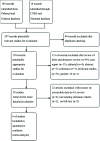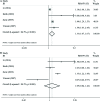The diagnostic value of narrow-band imaging for early and invasive lung cancer: a meta-analysis
- PMID: 28793005
- PMCID: PMC5525163
- DOI: 10.6061/clinics/2017(07)09
The diagnostic value of narrow-band imaging for early and invasive lung cancer: a meta-analysis
Abstract
This study aimed to compare the ability of narrow-band imaging to detect early and invasive lung cancer with that of conventional pathological analysis and white-light bronchoscopy. We searched the PubMed, EMBASE, Sinomed, and China National Knowledge Infrastructure databases for relevant studies. Meta-disc software was used to perform data analysis, meta-regression analysis, sensitivity analysis, and heterogeneity testing, and STATA software was used to determine if publication bias was present, as well as to calculate the relative risks for the sensitivity and specificity of narrow-band imaging vs those of white-light bronchoscopy for the detection of early and invasive lung cancer. A random-effects model was used to assess the diagnostic efficacy of the above modalities in cases in which a high degree of between-study heterogeneity was noted with respect to their diagnostic efficacies. The database search identified six studies including 578 patients. The pooled sensitivity and specificity of narrow-band imaging were 86% (95% confidence interval: 83-88%) and 81% (95% confidence interval: 77-84%), respectively, and the pooled sensitivity and specificity of white-light bronchoscopy were 70% (95% confidence interval: 66-74%) and 66% (95% confidence interval: 62-70%), respectively. The pooled relative risks for the sensitivity and specificity of narrow-band imaging vs the sensitivity and specificity of white-light bronchoscopy for the detection of early and invasive lung cancer were 1.33 (95% confidence interval: 1.07-1.67) and 1.09 (95% confidence interval: 0.84-1.42), respectively, and sensitivity analysis showed that narrow-band imaging exhibited good diagnostic efficacy with respect to detecting early and invasive lung cancer and that the results of the study were stable. Narrow-band imaging was superior to white light bronchoscopy with respect to detecting early and invasive lung cancer; however, the specificities of the two modalities did not differ significantly.
Conflict of interest statement
No potential conflict of interest was reported.
Figures






Similar articles
-
Narrow-band imaging bronchoscopy in the detection of premalignant airway lesions: a meta-analysis of diagnostic test accuracy.Ther Adv Respir Dis. 2015 Oct;9(5):207-16. doi: 10.1177/1753465815589698. Epub 2015 Jun 17. Ther Adv Respir Dis. 2015. PMID: 26085510
-
Comparison of the diagnostic efficacy of white light endoscopy and magnifying endoscopy with narrow band imaging for early gastric cancer: a meta-analysis.Gastric Cancer. 2016 Apr;19(2):543-552. doi: 10.1007/s10120-015-0500-5. Epub 2015 Apr 29. Gastric Cancer. 2016. PMID: 25920526
-
Diagnostic efficacy of magnifying endoscopy with narrow-band imaging for gastric neoplasms: a meta-analysis.PLoS One. 2015 Apr 9;10(4):e0123832. doi: 10.1371/journal.pone.0123832. eCollection 2015. PLoS One. 2015. PMID: 25856544 Free PMC article.
-
Diagnostic performance of magnifying narrow-band imaging for early gastric cancer: A meta-analysis.World J Gastroenterol. 2015 Jul 7;21(25):7884-94. doi: 10.3748/wjg.v21.i25.7884. World J Gastroenterol. 2015. PMID: 26167089 Free PMC article. Review.
-
Narrow-band imaging for screening of oral premalignant or cancerous lesions: A systematic review and meta-analysis.Clin Otolaryngol. 2021 May;46(3):501-507. doi: 10.1111/coa.13724. Epub 2021 Feb 4. Clin Otolaryngol. 2021. PMID: 33503320
Cited by
-
Early diagnosis of lung cancer: which is the optimal choice?Aging (Albany NY). 2021 Feb 11;13(4):6214-6227. doi: 10.18632/aging.202504. Epub 2021 Feb 11. Aging (Albany NY). 2021. PMID: 33591942 Free PMC article. Review.
-
Bronchoscopic diagnosis and treatment of endobronchial carcinoid: case report and review of the literature.Eur Respir Rev. 2021 Jan 6;30(159):200115. doi: 10.1183/16000617.0115-2020. Print 2021 Mar 31. Eur Respir Rev. 2021. PMID: 33408086 Free PMC article. Review.
-
Evaluation of Band Selection for Spectrum-Aided Visual Enhancer (SAVE) for Esophageal Cancer Detection.J Cancer. 2025 Jan 1;16(2):470-478. doi: 10.7150/jca.102759. eCollection 2025. J Cancer. 2025. PMID: 39744490 Free PMC article.
-
The value of narrow-band imaging bronchoscopy in diagnosing central lung cancer.Front Oncol. 2022 Sep 16;12:998770. doi: 10.3389/fonc.2022.998770. eCollection 2022. Front Oncol. 2022. PMID: 36185220 Free PMC article.
-
A Systematic Review Evaluating the Diagnostic Efficacy of Narrow-Band Imaging for Laryngeal Cancer Detection.Medicina (Kaunas). 2024 Jul 25;60(8):1205. doi: 10.3390/medicina60081205. Medicina (Kaunas). 2024. PMID: 39202487 Free PMC article.
References
-
- Goldstraw P, Crowley J, Chansky K, Giroux DJ, Groome PA, Rami-Porta R, et al. The IASLC Lung Cancer Staging Project: proposals for the revision of the TNM stage groupings in the forthcoming (seventh) edition of the TNM Classification of malignant tumours. J Thorac Oncol. 2007;2((8)):706–14. doi: 10.1097/JTO.0b013e31812f3c1a. - DOI - PubMed
-
- Cancer Facts & Figures 2005. Atlanta, GA: American Cancer Society; 2005.
Publication types
MeSH terms
LinkOut - more resources
Full Text Sources
Other Literature Sources
Medical

